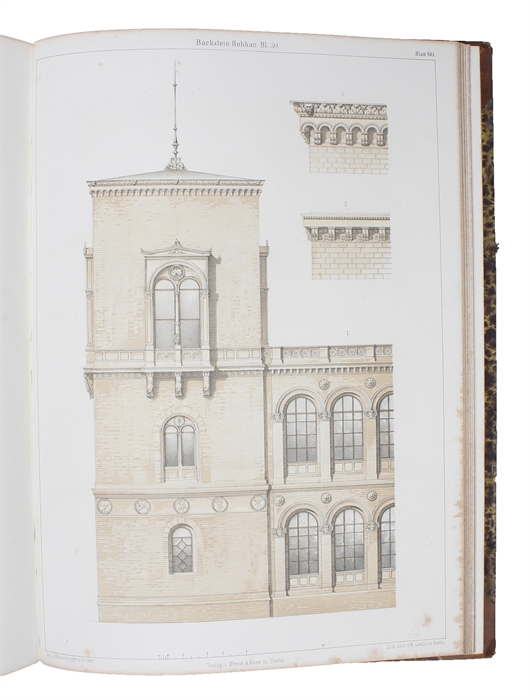BRICK-CONSTRUCTIONS.
Systematische Darstellung der Bau-Constructionen. Für den Unterricht and der Königlichen Bau=Akademie zu Berlin, bearbeitet von A.E.Fleischinger und W.A. Becker. Theil I: Die Maurerwerks=oder Stein=Constructionen.
Berlin, 1863.
Folio. Cont. hcalf. (108) pp. of text with many woodcut illustrations and 85 fine lithographed plates in colours, depicting details of bricklaying, patterns, houses etc. etc. Some plates slightly brownspotted.
Highly interesting German work on brick-constructions, which dates from the tumultous era of what is by some called the Second Industrial Revolution. This era included the rise of industrial powers such as USA and Germany, and it is not a coincidence that this interesting work on brick-construction is printed in Berlin.
From about 1830 and till the early 20th century, there was a revival of industrial building, which meant a large demand for bricks. Luckily, brick manufacturing methods had greatly improved since earlier centuries, and from the middle of the 18th century, the manufacturing process of bricks had become mechanized, and due to improvements in travel and communications, bricks could be transported over wide areas, which meant that there was no longer a need to stick to the locally produced type of brick.
The speed of construction during the Industrial Age demanded certain improvements, which were met with throughout the 19th century, e.g. the development of natural cements, and other hydraulic limes, which set quicker and were stronger.
The multitude of opportunities within the field allowed for numerous new trends and popular styles, as will be seen from the plates.
During the Renaissance and the Baroque, visible brick walls had been unpopular, and they were often covered up, and it was only from the mid 18th century that they began to become somewhat popular. The true popularity of the brick, however, probably only emerged with the possibilities in choosing different types and styles and with the constructing possibilities. During the nineteenth century bricks became the preferred material used for building, and in cities such as Boston and New York, locally made bricks were often much preferred. Brick was much to be favoured in these cities, when the trend of building upwards emerged during the last third of the nineteenth century, and it was chosen above cast, wrought iron and (later) steel and concrete.
Order-nr.: 9171



